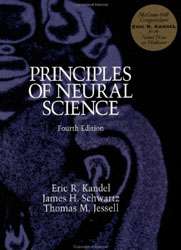Principles of Neural Science
First published in 1981 by Elsevier, Principles of Neural Science is an influential neuroscience textbook edited by Eric R. Kandel, James H. Schwartz, and Thomas M. Jessell. The original edition was 468 pages; now on the fifth edition, the book has grown to 1747 pages. The second edition was published in 1985, third in 1991, fourth in 2000. The fifth and latest edition was published on October 26th, 2012 and includes Steven A. Siegelbaum and A.J. Hudspeth as editors. [1] It has been hailed as the "Bible of Neuroscience" having been co-written by the 2000 Nobel Prize winner Eric Kandel. [2]

Authors
Editors
- Kandel was one of the recipients of the 2000 Nobel Prize in Physiology or Medicine. He is currently a professor of biochemistry, molecular biophysics, physiology, cellular biophysics, and psychiatry at Columbia University. He is a senior investigator at the Howard Hughes Medical Institute and a recipient of the National Medal of Science.
- Schwartz was a professor of physiology, cellular biophysics, neurology, and psychiatry at Columbia University.
- Jessell became an editor of the book starting from the third edition. He was a professor of biochemistry and molecular biophysics at Columbia University, and an investigator at the Howard Hughes Medical Institute.
- Hudspeth is a professor of sensory neuroscience at Rockefeller University. He is also an investigator at the Howard Hughes Medical Institute.
- Siegelbaum is Chair of the Department of Neuroscience at Columbia University and is also an investigator at the Howard Hughes Medical Institute.
Contributors
Including the editors—all of whom also contributed to individual chapters in the book—there are a total of 45 authors of this text. Included among them are several notable researchers and physicians. Several authors are also highly decorated scientists, including Nobel laureate Linda B. Buck and renowned neurophysiologist Roger M. Enoka.
Content
Principles of Neural Science is often assigned as a textbook for many undergraduate and graduate/medical neuroscience and neurobiology courses. The book attempts to at least introduce every aspect of our most modern understanding of the brain. The fifth edition is divided into sixty-seven chapters, organized into nine parts:
- Part I: Overall Perspective
- Part II: Cell and Molecular Biology of the Neuron
- Part III: Synaptic Transmission
- Part IV: The Neural Basis of Cognition
- Part V: Perception
- Part VI: Movement
- Part VII: The Unconscious and Conscious Processing of Neural Information
- Part VIII: Development and the Emergence of Behavior
- Part IX: Language, Thought, Affect, and Learning
References
- Kandel ER, Schwartz JH, Jessell TM 1991. Principles of Neural Science, 3rd ed. Appleton & Lange. ISBN 0-8385-8068-8
- Kandel ER, Schwartz JH, Jessell TM 2000. Principles of Neural Science, 4th ed. McGraw-Hill, New York. ISBN 0-8385-7701-6
- Kandel ER, Schwartz JH, Jessell TM 2012, Siegelbaum SA, Hudspeth AJ. 'Principles of Neural Science, 5th ed. McGraw-Hill, New York.ISBN 0-07-139011-1